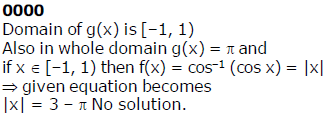JEE Exam > JEE Questions > f(x) = cos–1 (cos x) and g(x) = sin&nda...
Start Learning for Free
f(x) = cos–1 (cos x) and g(x) = sin–1 [x + 1] + cos–1 [x] (where [ * ] denotes greatest integer function), then find number of solutions of equation f(x) + g(x) = 3
Correct answer is '0'. Can you explain this answer?
| FREE This question is part of | Download PDF Attempt this Test |
Verified Answer
f(x) = cos–1 (cos x) and g(x) = sin–1 [x + 1] + cos–...

Most Upvoted Answer
f(x) = cos–1 (cos x) and g(x) = sin–1 [x + 1] + cos–...
The function f(x) = cos(x) represents the cosine function. The cosine function is a periodic function that oscillates between -1 and 1 as x varies. It has a period of 2π, meaning that the function repeats itself every 2π units along the x-axis. The graph of f(x) = cos(x) is a smooth, continuous curve that starts at (0, 1) and oscillates up and down symmetrically around the x-axis.
Attention JEE Students!
To make sure you are not studying endlessly, EduRev has designed JEE study material, with Structured Courses, Videos, & Test Series. Plus get personalized analysis, doubt solving and improvement plans to achieve a great score in JEE.

|
Explore Courses for JEE exam
|

|
Similar JEE Doubts
f(x) = cos–1 (cos x) and g(x) = sin–1 [x + 1] + cos–1 [x] (where [ * ] denotes greatest integer function), then find number of solutions of equation f(x) + g(x) = 3Correct answer is '0'. Can you explain this answer?
Question Description
f(x) = cos–1 (cos x) and g(x) = sin–1 [x + 1] + cos–1 [x] (where [ * ] denotes greatest integer function), then find number of solutions of equation f(x) + g(x) = 3Correct answer is '0'. Can you explain this answer? for JEE 2024 is part of JEE preparation. The Question and answers have been prepared according to the JEE exam syllabus. Information about f(x) = cos–1 (cos x) and g(x) = sin–1 [x + 1] + cos–1 [x] (where [ * ] denotes greatest integer function), then find number of solutions of equation f(x) + g(x) = 3Correct answer is '0'. Can you explain this answer? covers all topics & solutions for JEE 2024 Exam. Find important definitions, questions, meanings, examples, exercises and tests below for f(x) = cos–1 (cos x) and g(x) = sin–1 [x + 1] + cos–1 [x] (where [ * ] denotes greatest integer function), then find number of solutions of equation f(x) + g(x) = 3Correct answer is '0'. Can you explain this answer?.
f(x) = cos–1 (cos x) and g(x) = sin–1 [x + 1] + cos–1 [x] (where [ * ] denotes greatest integer function), then find number of solutions of equation f(x) + g(x) = 3Correct answer is '0'. Can you explain this answer? for JEE 2024 is part of JEE preparation. The Question and answers have been prepared according to the JEE exam syllabus. Information about f(x) = cos–1 (cos x) and g(x) = sin–1 [x + 1] + cos–1 [x] (where [ * ] denotes greatest integer function), then find number of solutions of equation f(x) + g(x) = 3Correct answer is '0'. Can you explain this answer? covers all topics & solutions for JEE 2024 Exam. Find important definitions, questions, meanings, examples, exercises and tests below for f(x) = cos–1 (cos x) and g(x) = sin–1 [x + 1] + cos–1 [x] (where [ * ] denotes greatest integer function), then find number of solutions of equation f(x) + g(x) = 3Correct answer is '0'. Can you explain this answer?.
Solutions for f(x) = cos–1 (cos x) and g(x) = sin–1 [x + 1] + cos–1 [x] (where [ * ] denotes greatest integer function), then find number of solutions of equation f(x) + g(x) = 3Correct answer is '0'. Can you explain this answer? in English & in Hindi are available as part of our courses for JEE.
Download more important topics, notes, lectures and mock test series for JEE Exam by signing up for free.
Here you can find the meaning of f(x) = cos–1 (cos x) and g(x) = sin–1 [x + 1] + cos–1 [x] (where [ * ] denotes greatest integer function), then find number of solutions of equation f(x) + g(x) = 3Correct answer is '0'. Can you explain this answer? defined & explained in the simplest way possible. Besides giving the explanation of
f(x) = cos–1 (cos x) and g(x) = sin–1 [x + 1] + cos–1 [x] (where [ * ] denotes greatest integer function), then find number of solutions of equation f(x) + g(x) = 3Correct answer is '0'. Can you explain this answer?, a detailed solution for f(x) = cos–1 (cos x) and g(x) = sin–1 [x + 1] + cos–1 [x] (where [ * ] denotes greatest integer function), then find number of solutions of equation f(x) + g(x) = 3Correct answer is '0'. Can you explain this answer? has been provided alongside types of f(x) = cos–1 (cos x) and g(x) = sin–1 [x + 1] + cos–1 [x] (where [ * ] denotes greatest integer function), then find number of solutions of equation f(x) + g(x) = 3Correct answer is '0'. Can you explain this answer? theory, EduRev gives you an
ample number of questions to practice f(x) = cos–1 (cos x) and g(x) = sin–1 [x + 1] + cos–1 [x] (where [ * ] denotes greatest integer function), then find number of solutions of equation f(x) + g(x) = 3Correct answer is '0'. Can you explain this answer? tests, examples and also practice JEE tests.

|
Explore Courses for JEE exam
|

|
Suggested Free Tests
Signup for Free!
Signup to see your scores go up within 7 days! Learn & Practice with 1000+ FREE Notes, Videos & Tests.
























